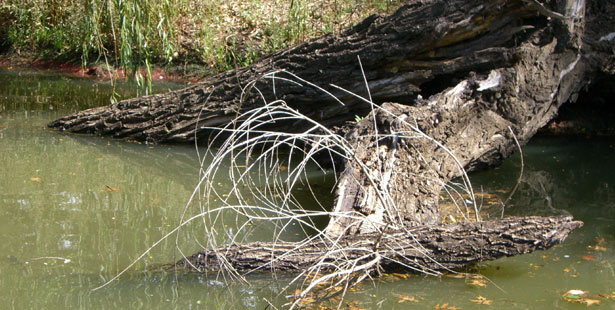Features
Thumping the Stumps
- Details
- Written by Darryl Quinton

Have you ever been driving down the road and seen a fallen tree and wondered what it would be like if it was surrounded by water? That perfect looking lay-down. I find myself positioning where the fish might be, where I would make my cast first and all sort of things run through my mind. Whether I’m going mad or just very passionate about catching these awesome sport fish I don’t know!
Catching bass around wood has to be one of my favourite pastimes. I find it to be a very challenging and rewarding technique and has helped me boat some really nice fish. I will share some of the techniques I use to find and catch these bass when they are in the woody cover.
Step #1: The approach
Let’s start off by stating that if your approach is good, you have already increased your chances of catching more bass off that particular lay-down. I always make sure that I stop my boat and my trolling motor is in the water by at least 20meters away. This allows my approach to be quiet and gives me enough time to position my boat to make that first presentation count. A very important one too. Most times you can get that fish to bite on that very first cast, that’s of course if he’s home. I look at the lay-down and identify the main trunk first. Does the tree have a fork? How far does this tree go into the water? What is the water depth? The time of year. All these points are important to me and help me decide where to position my boat to make my first cast. Always keep an open mind on your approach.
Step #2: That first cast
I’ve had really good success fishing the forks of most trees. The fork generally offers the most shade in most cases and offers the fish that perfect ambush situation to rush out and smash the prey (hopefully your bait). This is where I try putting my bait first. My personal favorite is to slow roll a Terminator spinnerbait from where the fork starts to the outside of the tree. I’ve had fish kill the bait on the first cast countless times. It works for me.
You will come across lay-downs that don’t have a lot of meat on them (hardly any limbs at all) this does not mean that the fish won’t relate to them. It means your approach will be different. Always try and picture what the tree looks like under water (picture that tree next to the road). Position your boat and make your first cast count. Put your bait in that strike zone and hold on. I would go for the main stem first and then slowly work my way around the tree.
The outer limbs at times could be more productive than the main stems. This could depend on both current and depth. I find when the water is too shallow around the main stems the fish move outwards and locate themselves amongst the finer brush. When you have a current situation the bass use these outer limbs as current breaks and wait to ambush passing prey. All these factors are just a few things to consider when making those first casts count.
Step #3: Bait selections
Now that we have covered just a few basic steps on approaching the lay-downs and where to make those first casts count, here are some baits that I believe will help you catch more bass off wood.
The first thing that runs through my mind is the all very important keyword, deflection.
My baits selections are very simple. If I can work my bait through the lay-down and bump every limb possible and not get snagged, I’m using the correct lure. One of my personal favourites is to crank through the wood. My number one lure preference would be the Rapala DT Flat series. These coffin shaped lures allows me the freedom to pull my crankbait through areas that most bassers won’t put a plastic bait into. These baits are designed to deflect off the cover and are made from balsa wood to allow for very high buoyancy which makes them almost snaggless. I can fish these baits through the thickest limbs to draw strikes that others possibly couldn’t. These bites are mostly reaction bites and are generally more aggressive.
Colour selection is also important when choosing your favourite crank. I mostly use bright colours in stained water and natural colours in cleaner water. However this is not always the case. I have had some awesome success with bright colours in clean water, especially during the spring months. Fish absolutely smash these brightly coloured baits right out of the water. I think if you catch the fish by surprise, it will react in ways you never imagined. Hold on!
What I recommend is that you keep a variety of colours and a selection of sizes. You never know what the day holds and which baits will work best. I also try to at least have two of everything available. You don’t want to lose your working crankbait and not have another one available. This could lead to some frustrating times, ask me! Always make sure that your hooks are super sharp at all times, particularly if you do get snagged. It takes a lot of discipline to do this, but please believe me, it’s worth it. If your hooks continuously need attention, change them. Sharp hooks and perfect bait presentation are sure winners. You can’t go wrong.
The next bait I love to use is the spinnerbait. These baits can also be worked methodically through the timber probing all the nooks and crannies to trigger strikes.
They also offer you that snagless luxury when working your favourite lay-downs. You will find that you need to alternate your blade selections depending on the water clarity. The ideal choice in cleaner water would be to use a willow leaf pattern with either a gold or silver blade. I would use bait fish presence to help me decide on this. Silver works best in cleaner water as it has awesome flash, and in stained water I find the gold blades to work best. Again you would have to mix these around on the day to work out which would give you the best results.
In really stained water, or if you want to slow down your retrieve, I go to a Colorado or Indiana blade choice. For no particular reason I prefer to use gold blades for this job. These blades offer you the most vibration and sometimes this is what the bass need to locate your baits.
When deciding on my skirt choice I use baitfish patterns or otherwise I use reaction colours such as chartreuse to encourage strikes. Always make sure that your skirts are well trimmed and look as natural as possible. A lot of anglers don’t really pay too much attention to their spinnerbaits they have just purchased. They remove the bait from the packaging and take it straight to the water and hope to have all the success in the world. Well, I can tell you that your hook is probably blunt and your skirt is too long. Any bait that is bought should be checked before tying it on. Sharpen the hook and trim your skirts and you will be surprised at the results.
Step #4: Tackle selection
Tackle selection is very important as you all know. It doesn’t help to have your boat positioned perfectly, to have the sharpest hooks, the best looking bait, your shining white cap but the wrong rod and reel. Everything can be ruined by this important factor. Please take special care when choosing your rod and reels. Make sure your rod can first of all pull that trophy bass from that lay-down with ease. Make sure you can crank that fish out with the right reel ratios. Make sure your line selection can withstand the abrasion resistance that might be thrown your way. Trying to haul a fish from the heart of a lay-down needs all the above to increase your success rate.
My personal preference for throwing my cranks is the G.Loomis crankbait rod. The model is the CBR845. This particular rod is rated up to 20lb line class and I can use up to a one-ounce bait. It’s a moderate fast action, which means it has a softer tip to maximize hook ups, but has the backbone that will pull a horse and cart. Ideal for cranking timber.
The reel I use is the Calais 200A. This reel offers me the freedom to put my bait anywhere without any backlashes and gives me 6.2:1 ratio to get the fish out of the cover I’m fishing. The reel is spooled with 15lb XX Powerline which gives me the power and abrasion resistance I need.
Your spinnerbait setup should have similar features. A lot of backbone and fairly fast retrieve ratio. My preference is the G.loomis SBR812 series rod. This is a 6’9 rod rated up to 17lb line and has all I need to get Mr. Bass from the tree. This is also coupled with a Shimano Calais 200a reel. I use 17-20 lb XX Powerline for this job.
I hope this helps you a little when approaching the next lay-down you are going to fish. These small adjustments have helped me over the years I hope it makes some small difference for you. Just remember: always keep a sharp hook, stay focused and positioned and you won’t get stumped by Mr. Bass!
Most importantly, enjoy your fishing!
* Darryl Quinton is a member of the Rapala/VMC Pro Staff team.


 Visit us our
Visit us our